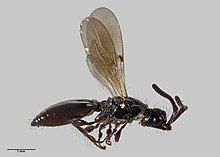| Neurogalesus carinatus | |
|---|---|

| |
| Neurogalesus carinatus from New Zealand | |
| Scientific classification | |
| Domain: | Eukaryota |
| Kingdom: | Animalia |
| Phylum: | Arthropoda |
| Class: | Insecta |
| Order: | Hymenoptera |
| Family: | Diapriidae |
| Genus: | Neurogalesus |
| Species: | N. carinatus |
| Binomial name | |
| Neurogalesus carinatus Kieffer, 1907 | |
| Synonyms | |
|
Neurogalesus hackeri Dodd, 1915 | |
Neurogalesus carinatus is a species of parasitic wasp in the family Diapriidae, first described in 1907. It uses the Australian soldier fly Inopus rubriceps as a host, sharing its range in pastured areas of South East Queensland, northern New South Wales and its non-native range on the North Island of New Zealand.
Description
Neurogalesus carinatus have deep red-coloured legs and antennae, with a female body length of up to 5.5mm. It can be distinguished from Neurogalesus dissimilis and Neurogalesus rubripes (two wasps with similar appearances) by having a sulcus on either side of the median groove at the base of the abdomen.
Distribution
The earliest recorded sighting of Neurogalesus carinatus in New Zealand is in 1985, after a specimen was collected from Māngere in Auckland. As of 2014, no specimens have been collected from New Zealand native bush environments, suggesting that the fly exclusively lives in urban environments and pastures. No species of fly other than Inopus rubriceps present in New Zealand are known to act as hosts for Neurogalesus carinatus.
References
- ^ Early, John W. (2014). "Establishment of two Neurogalesus Kieffer, 1907 species (Hymenoptera: Diapriidae: Diapriinae) in New Zealand". Papahou: Records of the Auckland Museum. 49: 15–20. ISSN 1174-9202. JSTOR 43264618. Wikidata Q58629012.
- ^ Dodd, Alan P. (1920). "Notes on the exotic Proctotrupoidea in the British and Oxford University Museums, with descriptions of new genera and species". Transactions of the Entomological Society of London. 67 (3–4): 321–382. doi:10.1111/j.1365-2311.1920.tb00008.x.
| Taxon identifiers | |
|---|---|
| Neurogalesus carinatus | |
This Apocrita-related article is a stub. You can help Misplaced Pages by expanding it. |